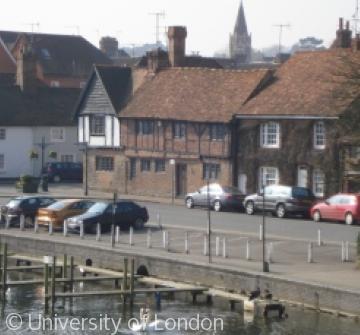Thameside

Henley grew up on the back of the Thames river trade with London, and from the Middle Ages the waterfront has been a vital part of the town. By the 14th century much of the riverside on both sides of the bridge was occupied by granaries (see map), many of which were owned at first by London-based corn-mongers, and later by wealthy Henley-based merchants such as John Elmes (died 1460). Most are long gone, though the long, jettied ranges at 67–73 Friday Street and 10 Thameside (partly dendro-dated to 1549) may be one survival, and the medieval Chantry House (which backs onto the river on the east) may also have originated as a trading building. Wharfs south of Friday Street and north of New Street were well established by the 16th or 17th century, and the whole of the waterfront was still used for loading huge Western barges in the 1780s, when Barrett March, owner of the Red Lion Inn, built new granaries along the stretch between Hart Street and New Street, adjoining the inn on the south.
With the decline of the river trade in the 19th century and its replacement by recreational boating and the Regatta, the character of Henley's waterfront began to change. A new embankment had already been built along the Hart Street to New Street stretch in the 1780s, and as the Regatta grew in popularity the riverbank was transformed by new boatyards, boathouses and hotels. River Terrace, an imposing block of white-stuccoed, three-storey houses south of Friday Street, was built in 1866 in the hope of attracting wealthy residents, though most ended up as up-market lodging houses. The neighbouring Royal Hotel followed in 1869, to be rebuilt in neo-Tudor style in 1899–1900 by the Reading architect G.W. Webb. Further north, the Red Lion granaries were replaced in 1888-9 by Tom Shepherd's boat-building sheds (now shops), which had a first-floor veranda for viewing the Regatta, and which built everything from skiffs to 80-foot steam yachts. The nearby Little White Hart was rebuilt in an extravagant ‘Old English’ style a few years later, its gabled roof-line enlivened by terracotta dragons. Beyond New Street private boathouses replaced the old commercial wharfs, two of them owned in 1901 by Frank Crisp of Friar Park and Colonel Makins of Rotherfield Court. The first permanent regatta grandstand went up near Phyllis Court in 1913, completing the essentials of the modern Henley riverscape. The striking Royal Regatta headquarters were built on the opposite (Berkshire) bank in 1986. But not all waterfront buildings were directly associated with the river. The Red Lion, whose riverside frontage extends some way along Thameside, was primarily associated with coaching, and was one of the first buildings which travellers approaching from London would see. Just south of the bridge stands the appropriately named Angel on the Bridge Hotel, which was established as an inn by the early 18th century, and which incorporates in its cellars part of an ancient stone arch left over from the demolished medieval bridge. Almost opposite stands the early 18th-century Old Rectory, one of Henley's most imposing houses, with its fine brick front and tall sash windows. For a time it was owned by the wealthy brewer James Brooks, before being acquired as a rectory house in the 1820s. Read the censuses for Thameside and the waterfront (see Assets opposite). Or find out more about the river trade, Henley's bargemen, and the Regatta. .
Content generated during research for the paperback book 'Henley-on-Thames: Town, Trade and River' (ISBN 13 : 978-1-86077-554-3) for the England's Past for Everyone series









